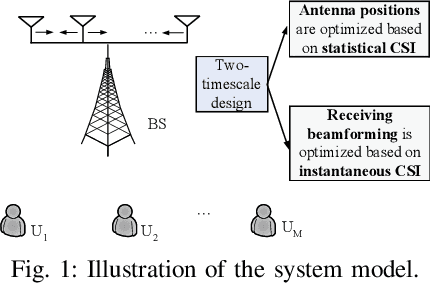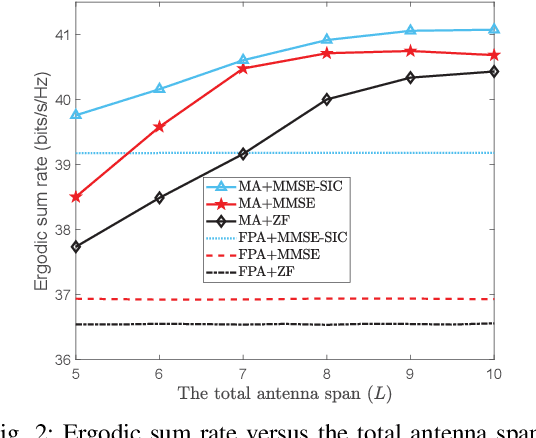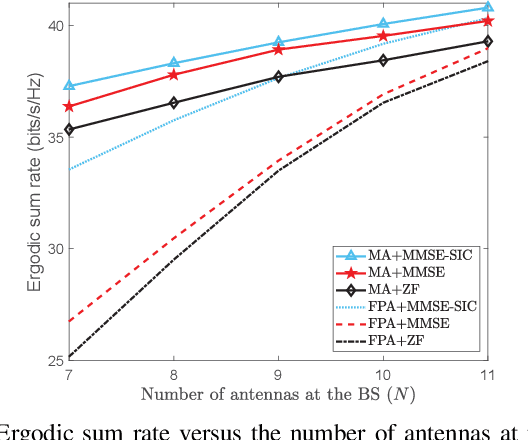Jiangbo Si
Movable Frequency Diverse Array-Assisted Covert Communication With Multiple Wardens
Jul 26, 2024



Abstract:The frequency diverse array (FDA) is highly promising for improving covert communication performance by adjusting the frequency of each antenna at the transmitter. However, when faced with the cases of multiple wardens and highly correlated channels, FDA is limited by the frequency constraint and cannot provide satisfactory covert performance. In this paper, we propose a novel movable FDA (MFDA) antenna technology where positions of the antennas can be dynamically adjusted in a given finite region. Specifically, we aim to maximize the covert rate by jointly optimizing the antenna beamforming vector, antenna frequency vector and antenna position vector. To solve this non-convex optimization problem with coupled variables, we develop a two-stage alternating optimization (AO) algorithm based on the block successive upper-bound minimization (BSUM) method. Moreover, considering the challenge of obtaining perfect channel state information (CSI) at multiple wardens, we study the case of imperfect CSI. Simulation results demonstrate that MFDA can significantly enhance covert performance compared to the conventional FDA. In particular, when the frequency constraint is strict, MFDA can further increase the covert rate by adjusting the positions of antennas instead of the frequencies.
Movable Frequency Diverse Array for Wireless Communication Security
Jul 26, 2024



Abstract:Frequency diverse array (FDA) is a promising antenna technology to achieve physical layer security by varying the frequency of each antenna at the transmitter. However, when the channels of the legitimate user and eavesdropper are highly correlated, FDA is limited by the frequency constraint and cannot provide satisfactory security performance. In this paper, we propose a novel movable FDA (MFDA) antenna technology where the positions of antennas can be dynamically adjusted in a given finite region. Specifically, we aim to maximize the secrecy capacity by jointly optimizing the antenna beamforming vector, antenna frequency vector and antenna position vector. To solve this non-convex optimization problem with coupled variables, we develop a two-stage alternating optimization (AO) algorithm based on block successive upper-bound minimization (BSUM) method. Moreover, to evaluate the security performance provided by MFDA, we introduce two benchmark schemes, i.e., phased array (PA) and FDA. Simulation results demonstrate that MFDA can significantly enhance security performance compared to PA and FDA. In particular, when the frequency constraint is strict, MFDA can further increase the secrecy capacity by adjusting the positions of antennas instead of the frequencies.
Two-Timescale Design for Movable Antenna Array-Enabled Multiuser Uplink Communications
Jul 25, 2024


Abstract:Movable antenna (MA) technology can flexibly reconfigure wireless channels by adjusting antenna positions in a local region, thus owing great potential for enhancing communication performance. This letter investigates MA technology enabled multiuser uplink communications over general Rician fading channels, which consist of a base station (BS) equipped with the MA array and multiple single-antenna users. Since it is practically challenging to collect all instantaneous channel state information (CSI) by traversing all possible antenna positions at the BS, we instead propose a two-timescale scheme for maximizing the ergodic sum rate. Specifically, antenna positions at the BS are first optimized using only the statistical CSI. Subsequently, the receiving beamforming at the BS (for which we consider the three typical zero-forcing (ZF), minimum mean-square error (MMSE) and MMSE with successive interference cancellation (MMSE-SIC) receivers) is designed based on the instantaneous CSI with optimized antenna positions, thus significantly reducing practical implementation complexities. The formulated problems are highly non-convex and we develop projected gradient ascent (PGA) algorithms to effectively handle them. Simulation results illustrate that compared to conventional fixed-position antenna (FPA) array, the MA array can achieve significant performance gains by reaping an additional spatial degree of freedom.
Movable-Antenna Array Enabled Multiuser Uplink: A Low-Complexity Gradient Descent for Total Transmit Power Minimization
Dec 10, 2023



Abstract:We investigate multiuser uplink communication from multiple single-antenna users to a base station (BS), which is equipped with a movable-antenna (MA) array and adopts zero-forcing receivers to decode multiple signals. We aim to optimize the MAs' positions at the BS, to minimize the total transmit power of all users subject to the minimum rate requirement. After applying transformations, we show that the problem is equivalent to minimizing the sum of each eigenvalue's reciprocal of a matrix, which is a function of all MAs' positions. Subsequently, the projected gradient descent (PGD) method is utilized to find a locally optimal solution. In particular, different from the latest related work, we exploit the eigenvalue decomposition to successfully derive a closed-form gradient for the PGD, which facilitates the practical implementation greatly. We demonstrate by simulations that via careful optimization for all MAs' positions in our proposed design, the total transmit power of all users can be decreased significantly as compared to competitive benchmarks.
Secure Wireless Communication via Movable-Antenna Array
Nov 13, 2023



Abstract:Movable antenna (MA) array is a novel technology recently developed where positions of transmit/receive antennas can be flexibly adjusted in the specified region to reconfigure the wireless channel and achieve a higher capacity. In this letter, we, for the first time, investigate the MA array-assisted physical-layer security where the confidential information is transmitted from a MA array-enabled Alice to a single-antenna Bob, in the presence of multiple single-antenna and colluding eavesdroppers. We aim to maximize the achievable secrecy rate by jointly designing the transmit beamforming and positions of all antennas at Alice subject to the transmit power budget and specified regions for positions of all transmit antennas. The resulting problem is highly non-convex, for which the projected gradient ascent (PGA) and the alternating optimization methods are utilized to obtain a high-quality suboptimal solution. Simulation results demonstrate that since the additional spatial degree of freedom (DoF) can be fully exploited, the MA array significantly enhances the secrecy rate compared to the conventional fixed-position antenna (FPA) array.
Intelligent Reflecting Surface-Aided Wireless Communication with Movable Elements
Nov 04, 2023Abstract:Intelligent reflecting surface (IRS) has been recognized as a powerful technology for boosting communication performance. To reduce manufacturing and control costs, it is preferable to consider discrete phase shifts (DPSs) for IRS, which are set by default as uniformly distributed in the range of $[ - \pi,\pi )$ in the literature. Such setting, however, cannot achieve a desirable performance over the general Rician fading where the channel phase concentrates in a narrow range with a higher probability. Motivated by this drawback, we in this paper design optimal non-uniform DPSs for IRS to achieve a desirable performance level. The fundamental challenge is the \textit{possible offset in phase distribution across different cascaded source-element-destination channels}, if adopting conventional IRS where the position of each element is fixed. Such phenomenon leads to different patterns of optimal non-uniform DPSs for each IRS element and thus causes huge manufacturing costs especially when the number of IRS elements is large. Driven by the recently emerging fluid antenna system (or movable antenna technology), we demonstrate that if the position of each IRS element can be flexibly adjusted, the above phase distribution offset can be surprisingly eliminated, leading to the same pattern of DPSs for each IRS element. Armed with this, we then determine the form of unified non-uniform DPSs based on a low-complexity iterative algorithm. Simulations show that our proposed design significantly improves the system performance compared to competitive benchmarks.
 Add to Chrome
Add to Chrome Add to Firefox
Add to Firefox Add to Edge
Add to Edge